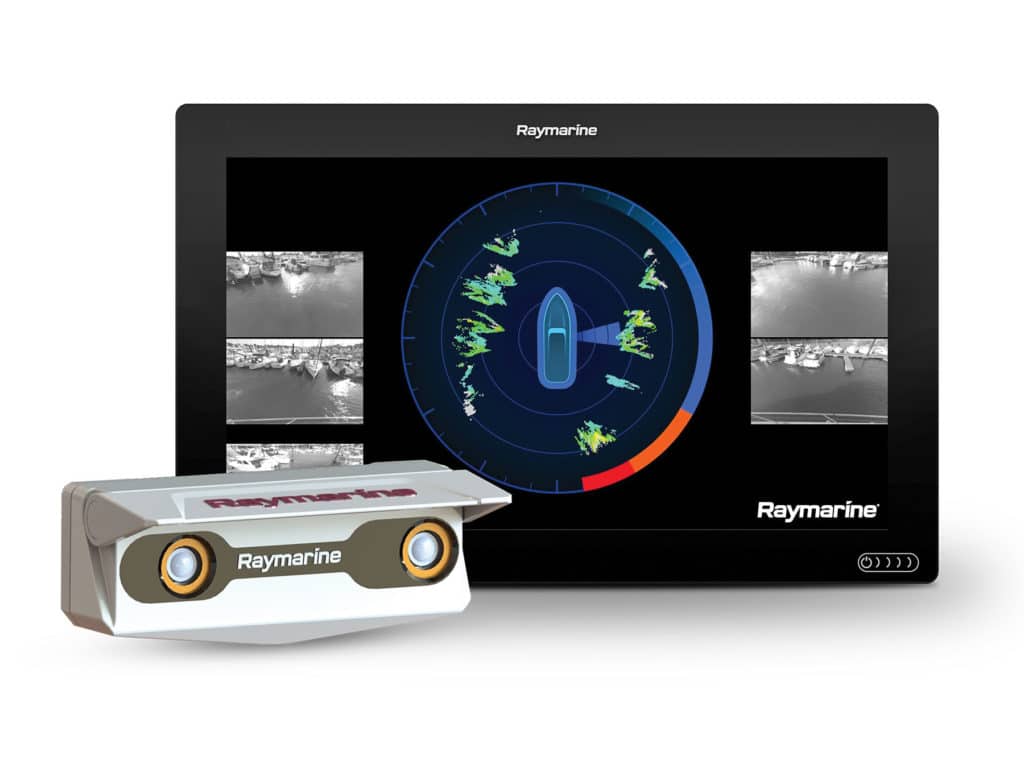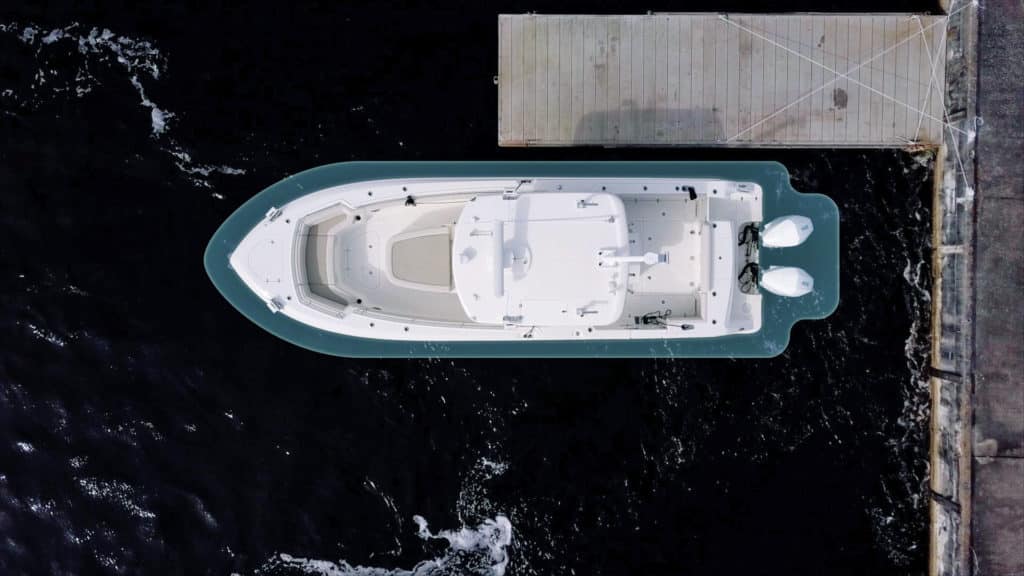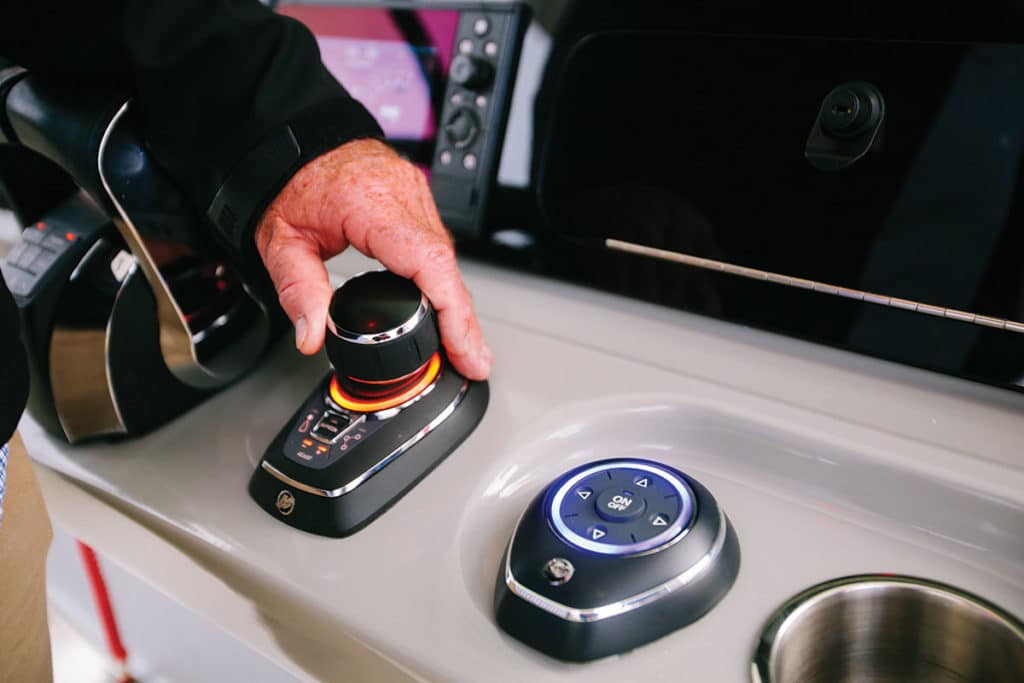
Raymarine DockSense
Today, a growing number of automobiles with parking- assistance technology are sliding into parking spots on streets around the world. Such systems, usually offered as optional, help drivers put cars into tight spaces with little or no input to the steering wheel, and no scrapes or dents. The technology has become so common that U.S. News & World Report published a list of the 20 best self-parking cars last year.
Now, similar technology is finding its way into power boats. One has emerged in a prototype system developed between FLIR/Raymarine and Mercury Marine aboard a Boston Whaler 330 Outrage with twin Mercury 300 Verado outboards. FLIR/Raymarine has also developed an inboard prototype in conjunction with Prestige Yachts. The system aboard the Prestige 460 works with twin diesel engines and pod drives.
At the same time, Volvo Penta is evaluating a proprietary self-docking system in a 68-foot yacht, powered by twin Volvo Penta diesel inboards with IPS pod drives.
All of these systems tie into the boats’ joystick controls, and all promise to automate the task of parking a boat in a tight spot without suffering drama, dings or dock rash.
Autonomous Approach Volvo Penta is pioneering true self-docking capabilities. Its automated system uses an onboard, electronic vessel-control system, which computes steering and drive calculations in relation to the boat’s actual position, and four sensors sited on the intended berth, according to Volvo. That means it works only at docks fitted with those sensors.
As the boat nears its berth, the system recognizes that it has entered a “catch zone” and sends out a signal to the helmsman that it’s ready to dock. Once the captain activates the self-docking function on the joystick control, the boat automatically moves into a “docking ready” position. Then the helmsman initiates the final self-docking stage, allowing the system to use a combination of GPS and sensors (on board and at the berth) to dock the boat without contacting docks, pilings, seawalls or other boats, Volvo says.
If needed, the helmsman can pause the docking sequence, and the system will hold the boat stationary in the water, even in the face of wind and current. Volvo Penta has not yet announced when the system will be available or how much it will cost.
Docking Assistance FLIR/Raymarine calls its assisted-docking system DockSense. It employs artificial intelligence to recognize hazards, and then augments a joystick low-speed control system to prevent the boat from banging into docks, seawalls and adjacent vessels.
Unlike the Volvo self-docking system, DockSense does not completely take over, and it doesn’t require sensors at the berth. “It uses onboard cameras and sensors that interface with the boat’s joystick system to ensure that the vessel enters the dock safely,” says Jim McGowan, marketing manager for FLIR/Raymarine. DockSense assists the captain by automatically applying steering corrections and directional engine thrust when it senses a rate of closure that might lead to contact, McGowan explains.
The technology behind DockSense relies on a network of FLIR machine-vision cameras. Each is equipped with two lenses that lend it three-dimensional depth perception and the ability to measure distances up to 66 feet.
On a typical setup, such as the one on the Boston Whaler 330 Outrage that I tested, there are five onboard cameras: one each on the port and starboard bow areas, one each on the port and starboard hardtop areas, and one up high amidships facing aft.
In addition, the machine cameras are equipped with attitude- and heading-reference-system (AHRS) sensors, and they can communicate among themselves. Each camera can tell the others how it’s moving, McGowan says. The system also relies on GPS for speed sensing.
“All of the views overlap slightly, and the images are stitched together in a model for a 360-degree virtual view around the boat,” he explains. That view can be shown only on a Raymarine Axiom multifunction display.

Virtual Bumpers Data is fed via Ethernet cables into the DockSense central processor, and then networked with the joystick-control system and Axiom MFD. Most important, DockSense allows you to set what Raymarine calls “virtual bumper” zones that generate an invisible collar around the boat. This lets you maintain a distance between the boat and hard targets of up to 10 feet.
“If the system detects a rate of closure that might lead to contact with an object, it adjusts to hold at the distance set for the virtual bumper,” McGowan explains. “It is not reactive, but rather very proactive in sensing trends.”
As configured aboard the 330 Outrage, DockSense returns the boat to neutral if you let go of the joystick. The system then maintains boat position and heading. All other joystick rules apply. If the joystick requires that the engines are trimmed down, for example, that would also be the case with DockSense. You can also turn it off.

Firsthand Experience I had the chance to experience the DockSense system aboard the 330 Outrage during the 2019 Miami International Boat Show in February. In this specific setup, we turned on DockSense using a separate keypad. This function might be integrated into the joystick control in future versions.
Each of the four bumper zones can be set for a different distance. Arrows on the keypad light up green when the boat is outside the bumper zone, but will flash red as you get near a zone and stay red once you have reached it. Neither you nor wind nor current can move the boat past the bumper zone when the feature is activated.
The view of surrounding objects on the Axiom display (using the special DockSense app) looks very much like radar, with the boat image in the center. By keeping you posted on the boat’s relationship to the dock and other hazards, this engenders situational awareness and confidence.
Watch: Video: Mercury Marine’s Joystick Piloting
As the system sensed pending contact and applied corrections, I did not experience any last-minute application of violent thrust or sudden steering changes. The automatic corrections seemed subtle and gentle. To dock the boat, you can disengage DockSense and nudge the joystick for the final few feet.
FLIR/Raymarine hopes to make DockSense available later this year but has not yet put a firm date on its introduction or set pricing.
Whenever such systems reach boating customers, they will most certainly represent a major step closer to the development of a self-driving boat. Indeed, sources tell me that Mercury Marine is currently in pursuit of this goal. The age of autonomous boats might arrive sooner than you think.




